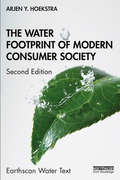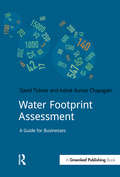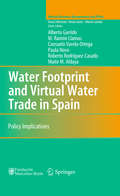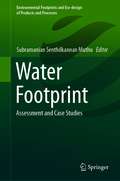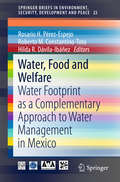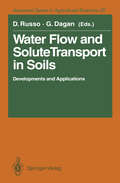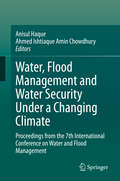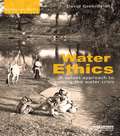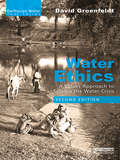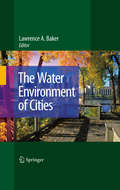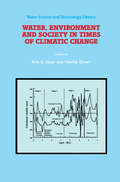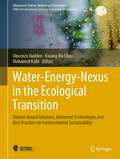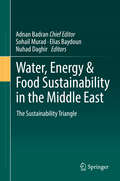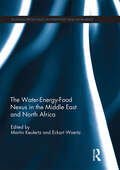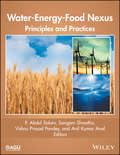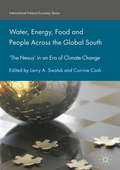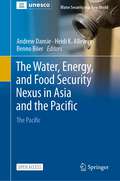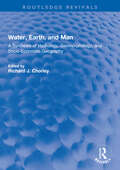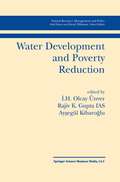- Table View
- List View
The Water Footprint of Modern Consumer Society (Earthscan Water Text)
by Arjen Y. HoekstraUsing the water footprint concept, this impactful book aids our understanding of how we can reduce water consumption and pollution to sustainable levels. Since the publication of the first edition, the question of how to reduce our water footprint has become even more urgent. Freshwater scarcity is increasingly perceived as a global systemic risk and overconsumption of water is widespread. The water footprint, a concept founded by the author, is an indicator of direct and indirect freshwater use by a consumer or producer that can be used to analyze water usage along supply chains and assess the sustainability, efficiency and fairness of our water use. This new edition is fully revised and updated to reflect continued developments in this rapidly growing field of knowledge. New chapters are added covering the history of the water footprint concept; the environmental footprint of the human species versus planetary boundaries; and the human right to water as a foundation to equitable sharing. All other chapters are fully revised with new findings, applications and references, including major new research on energy, vegetarian diets and intelligent water allocation over competing demands. The Water Footprint of Modern Consumer Society is a key textbook for students of interdisciplinary water studies and those taking other related courses within the environmental sciences. It will also be of interest to those working in the governmental sector, environmental and consumer organizations, the business sector and UN institutions, where there is growing interest in the water footprint concept.
Water Footprint Assessment: A Guide for Business
by David Tickner Ashok Kumar ChapagainAs business risks associated with water intensify – for example risks to oeprations, supply chains and reputation – many corporate sustainability professionals are seeking practical tools to help them understand and assess these risks. Water Footprint Assessment tools developed primarily by the research sector are gaining attention in this context. However, there is debate among experts and non-experts about the merits of this approach. Water Footprint Assessment: A Business Guide is a concise and comprehensive digest of emerging concepts, tools and arguments around water footprint approaches. Specifically aimed at business audiences, this definitive short guide to the issues distils the latest in scientific and policy literature, helps sustainability leaders understand what they can, and can't do with water footprint tools, includes practical experience and case studies and outlines the pros and cons of using Water Footprint Assessment and similar approaches.
Water Footprint Assessment: A Guide for Business (Doshorts Ser.)
by David Tickner Ashok Kumar ChapagainAs business risks associated with water intensify – for example risks to oeprations, supply chains and reputation – many corporate sustainability professionals are seeking practical tools to help them understand and assess these risks. Water Footprint Assessment tools developed primarily by the research sector are gaining attention in this context. However, there is debate among experts and non-experts about the merits of this approach. Water Footprint Assessment: A Business Guide is a concise and comprehensive digest of emerging concepts, tools and arguments around water footprint approaches. Specifically aimed at business audiences, this definitive short guide to the issues distils the latest in scientific and policy literature, helps sustainability leaders understand what they can, and can't do with water footprint tools, includes practical experience and case studies and outlines the pros and cons of using Water Footprint Assessment and similar approaches.
Water Footprint and Virtual Water Trade in Spain: Policy Implications (Natural Resource Management and Policy #35)
by Alberto Garrido M. Ramón Llamas Consuelo Varela-Ortega Paula Novo Roberto Rodríguez-Casado Maite M. Aldaya1.1 General Framework In most arid and semi-arid countries, water resource management is an issue that is both important and controversial. Most water resources experts now acknowledge that water conflicts are not caused by physical scarcity but are mainly due to poor water management (Rosegrant et al. 2002; Benoit and Comeau 2005; Comprehensive Assessment of Water Management in Agriculture 2007; Garrido and Dinar 2010, among others). The scientific and technological advances of the past 50 years have led to new ways to solve many water-related conflicts, often with tools that seemed unthinkable a few decades ago (Llamas 2005; Lopez-Gunn and Llamas 2008). This study deals with the estimation and analysis of Spain’s water footprint, both from a hydrological and economic perspective. Its ultimate objective is to report on the allocative efficiency of water and economic resources. This analysis can provide a transparent and multidisciplinary framework for informing and optimising water policy decisions, contributing at the same time to the implementation of the EU Water Framework Directive (WFD) (2000/60/EC). It also responds to the current mandate of the Spanish Ministry of Environment and Rural and Marine Affairs, which recently issued instructions for drafting river basin management plans in compliance with the EU Water Framework Directive, with a deadline of end of year 2009 and then every 6 years (BOE 2008).
Water Footprint: Assessment and Case Studies (Environmental Footprints and Eco-design of Products and Processes)
by Subramanian Senthilkannan MuthuThis book highlights the concept of water footprint in different industrial sectors such as leather tanning, steel, agriculture, textile and wine. One of the very basic necessities of life which is soon going to be scarce is water, hence the environmental footprint assessments on any scale essentially includes water footprint which is being measured in various supply chains and across different product categories. According to ISO 14046, the water footprint assessment refers to the total freshwater volume consumed and polluted directly or indirectly across a product’s end-to-end supply chain. This book presents, for industry purposes, the focus on identification and quantification of water trade, the scarcity, and pollution involved in the production of goods and services.
Water, Food and Welfare: Water Footprint as a Complementary Approach to Water Management in Mexico (SpringerBriefs in Environment, Security, Development and Peace #23)
by Rosario Pérez-Espejo Roberto M. Constantino-Toto Hilda R. Dávila-IbáñezThis book addresses the following topics: the contemporary model for water management and alternative approaches; the socioeconomic framework, water policy and institutions; water use for food purposes, water-resources inventory and irrigation; manifestations of welfare loss and water prices; change in dietary patterns and water security; hydrological stress and pressures on water availability; groundwater management problems; vulnerability and climate change; water demand of major crops; gray water footprint and water pollution; gray water footprint and mining; virtual water and food trade; estimates of the water footprint of four key cereals, forage, livestock and bottled drinks. It is the result of a cooperation between 16 researchers from eleven Mexican academic institutions.
Water Flow and Solute Transport in Soils: Developments and Applications In Memoriam Eshel Bresler (1930–1991) (Advanced Series in Agricultural Sciences #20)
by David Russo Gedeon DaganA year has passed since Eshel Bresler, my good friend and colleague, and a member of the editorial board of the Advanced Series in Agricultural Sciences, died suddenly while on a visit to the Chinese Academy of Sciences in Beijing. We had worked together for almost 30 years at the Institute of Soils and Water, ARO, The Volcani Center at Bet Dagan. At the very beginning of our scientific careers we cooperated directly and as a result one of our first publications was coauthored (Soil Sci. 101:205-209, 1966). Thereafter, our specific research interests diver sified, but we continued to work together, with similar approaches to research, and to strive towards the development of Israel soil science and its integration into general worldwide scientific progress. I don't need to emphasize Eshel's contribution to the understan ding of the processes governing water flow and solute transport pro cesses in soils and unsaturated zones. The contributions to this Volume by such a body of outstanding scientists shows the apprecia tion of the international scientific community to his research achievements.
Water, Flood Management and Water Security Under a Changing Climate: Proceedings from the 7th International Conference on Water and Flood Management
by Anisul Haque Ahmed Ishtiaque Amin ChowdhuryThis book presents selected papers from the 7th International Conference on Water and Flood Management,with a special focus on Water Security under Climate Change, held in Dhaka, Bangladesh in March 2019. The biennial conference is organized by Institute of Water and Flood Management of Bangladesh University of Engineering and Technology. The recent decades have experienced more frequent natural calamities and it is believed that climate change is an important driving factor for such hazards. Each part of the hydrological cycle is affected by global climate change. Moreover, increasing population and economic activities are posing a bigger threat to water sources. To ensure sustainable livelihoods, safeguard ecosystem services, and enhance socio-economic development, water security needs to be investigated widely in a global and regional context.
Water Ethics: A Values Approach to Solving the Water Crisis
by David GroenfeldtThis book introduces the idea that ethics are an intrinsic dimension of any water policy, program, or practice, and that understanding what ethics are being acted out in water policies is fundamental to an understanding of water resource management. Thus in controversies or conflicts over water resource allocation and use, an examination of ethics can help clarify the positions of conflicting parties as preparation for constructive negotiations. The author shows the benefits of exposing tacit values and motivations and subjecting these to explicit public scrutiny where the values themselves can be debated. The aim of such a process is to create the proverbial 'level playing field', where values favoring environmental sustainability are considered in relation to values favoring short-term exploitation for quick economic stimulus (the current problem) or quick protection from water disasters (through infrastructure which science suggests is not sustainable). The book shows how new technologies, such as drip irrigation, or governance structures, such as river basin organizations are neither "good" nor "bad" in their own right, but can serve a range of interests which are guided by ethics. A new ethic of coexistence and synergies with nature is possible, but ultimately depends not on science, law, or finances but on the values we choose to adopt. The book includes a wide range of case studies from countries including Australia, India, Philippines, South Africa and USA. These cover various contexts including water for agriculture, urban, domestic and industrial use, the rights of indigenous people and river, watershed and ecosystem management.
Water Ethics: A Values Approach to Solving the Water Crisis
by David GroenfeldtThis book introduces the idea that ethics are an intrinsic dimension of any water policy, program, or practice, and that understanding what ethics are being acted out in water policies is fundamental to an understanding of water resource management. Thus in controversies or conflicts over water resource allocation and use, an examination of ethics can help clarify the positions of conflicting parties as preparation for constructive negotiations. The author shows the benefits of exposing tacit values and motivations and subjecting these to explicit public scrutiny where the values themselves can be debated. The aim of such a process is to create the proverbial 'level playing field', where values favoring environmental sustainability are considered in relation to values favoring short-term exploitation for quick economic stimulus (the current problem) or quick protection from water disasters (through infrastructure which science suggests is not sustainable). The book shows how new technologies, such as drip irrigation, or governance structures, such as river basin organizations are neither "good" nor "bad" in their own right, but can serve a range of interests which are guided by ethics. A new ethic of coexistence and synergies with nature is possible, but ultimately depends not on science, law, or finances but on the values we choose to adopt. The book includes a wide range of case studies from countries including Australia, India, Philippines, South Africa and USA. These cover various contexts including water for agriculture, urban, domestic and industrial use, the rights of indigenous people and river, watershed and ecosystem management.
Water Ethics: A Values Approach to Solving the Water Crisis (Earthscan Water Text)
by David GroenfeldtFully revised and updated, this second edition of Water Ethics continues to consolidate water ethics as a key dimension of water-related decisions. The book introduces the idea that ethics are an intrinsic dimension of any water policy, program, or practice, and that understanding what ethics are being acted out in water policies is fundamental to an understanding of water resource management. Alongside updated references and the introduction of discussion questions and recommended further reading, this new edition discusses in depth three significant developments since the publication of the first edition in 2013. The first is the growing awareness of the climate crisis as an existential threat, and associated concern about adaptive strategies for sustainable water management and ways of using water management for climate mitigation (e.g., practically through agricultural soil management and conceptually through ethics awareness). Second, there has been increased clarity among the religious community, Indigenous leaders, and progressive academics that ethics needs to become an arena for application and action (e.g., the Vatican encyclical Laudato Si, protests at Standing Rock and Flint, Michigan, in the US, and climate demonstrations worldwide). Thirdly, there have been new normative water standards ranging from "water stewardship" (industry initiative), water charters (Berlin) and the on-going initiative to develop a global water ethics charter. Drawing on case studies from countries including Australia, India, the Philippines, South Africa, and the United States, this textbook is essential reading for students of environmental ethics and water governance and management.
Water Ethics: A Values Approach to Solving the Water Crisis (Earthscan Water Text)
by David GroenfeldtFully revised and updated, this second edition of Water Ethics continues to consolidate water ethics as a key dimension of water-related decisions. The book introduces the idea that ethics are an intrinsic dimension of any water policy, program, or practice, and that understanding what ethics are being acted out in water policies is fundamental to an understanding of water resource management. Alongside updated references and the introduction of discussion questions and recommended further reading, this new edition discusses in depth three significant developments since the publication of the first edition in 2013. The first is the growing awareness of the climate crisis as an existential threat, and associated concern about adaptive strategies for sustainable water management and ways of using water management for climate mitigation (e.g., practically through agricultural soil management and conceptually through ethics awareness). Second, there has been increased clarity among the religious community, Indigenous leaders, and progressive academics that ethics needs to become an arena for application and action (e.g., the Vatican encyclical Laudato Si, protests at Standing Rock and Flint, Michigan, in the US, and climate demonstrations worldwide). Thirdly, there have been new normative water standards ranging from "water stewardship" (industry initiative), water charters (Berlin) and the on-going initiative to develop a global water ethics charter. Drawing on case studies from countries including Australia, India, the Philippines, South Africa, and the United States, this textbook is essential reading for students of environmental ethics and water governance and management.
The Water Environment of Cities
by Lawrence A. BakerThe concept for the Water Environment of Cities arose from a workshop “Green 1 Cities, Blue Waters” workshop held in 2006. The workshop assembled experts from engineering, planning, economics, law, hydrology, aquatic ecology, geom- phology, and other disciplines to present research ?ndings and identify key new ideas on the urban water environment. At a lunch discussion near the end of the workshop, several of us came to the recognition that despite having considerable expertise in a narrow discipline, none of us had a vision of the “urban water en- ronment” as a whole. We were, as in the parable, blind men at opposite ends of the elephant, knowinga great deal about the parts, but notunderstandingthe whole. We quickly recognized the need to develop a book that would integrate this knowledge to create this vision. The goal was to develop a book that could be used to teach a complete, multidisciplinary course, “The Urban Water Environment”, but could also be used as a supplemental text for courses on urban ecosystems, urban design, landscapearchitecture,water policy,waterqualitymanagement andwatershed m- agement. The book is also valuable as a reference source for water professionals stepping outside their arena of disciplinary expertise. The Water Environment of Cities is the ?rst book to use a holistic, interdis- plinary approach to examine the urban water environment. We have attempted to portrayaholisticvisionbuiltaround theconcept of water as a coreelement ofcities. Water has multipleroles:municipalwatersupply,aquatichabitat,landscapeaesth- ics, and recreation. Increasingly, urban water is reused, serving multiple purposes.
Water, Environment and Society in Times of Climatic Change: Contributions from an International Workshop within the framework of International Hydrological Program (IHP) UNESCO, held at Ben-Gurion University, Sede Boker, Israel from 7–12 July 1996 (Water Science and Technology Library #31)
by NevilleBrown Arie S. IssarSince the greenhouse effect emerged as a predictable threat, necessitating the evalu ation of its future impact on the environment in the various parts of the globe, interest in the climate changes during the Holocene has gained momentum. The background can be summarized by the sentence: The past is a key to the future. As a matter of fact, this sentence is in the opposite direction, on the dimension of time, to the principle adopted by the founders of the science of geology. They proposed that geological processes in the present should be used as a key for understanding the past. Another reason for the interest in the history of the climate of the Holocene can be described as the renaissance of a modified deterministic approach to the inter relation between physical and human geography. This relates in the first place to the fact that various investigations, especially as carried out by Hubert Lamb, showed that the sequence of climate changes previously suggested by Blytt and Sernander for Europe and adopted by most Holocene climatologists was far too general, and that there were more climate changes during recent history than previously taken account of. In the second place it was found out that these changes had had an impact on the history of human communities. Thus, one can conclude that once the taboo on geographical determinism (i. e.
Water-Energy-Nexus in the Ecological Transition: Natural-Based Solutions, Advanced Technologies and Best Practices for Environmental Sustainability (Advances in Science, Technology & Innovation)
by Vincenzo Naddeo Kwang-Ho Choo Mohamed KsibiThis volume includes selected contributions presented during the 3rd edition of the international conference on WaterEnergyNEXUS, which was held in Tunisia in December 2020. This conference was organized by the University of Sfax (Tunisia), in cooperation with the Sanitary Environmental Engineering Division (SEED) of the University of Salerno (Italy), the Advanced Institute of Water Industry at Kyungpook National University (Korea) and The Energy and Resources Institute, TERI (India). The WaterEnergyNEXUS series of conferences are supported by the UNESCO World Water Association Programme (WWAP) and the International Water Association (IWA). It also enjoys the patronage of several international scientific societies, associations and organizations and has established a publishing partnership with Springer Nature. With the support of international experts invited as plenary and keynote speakers, the conference aimed to give a platform for Euro-Mediterranean countries to share and discuss key topics on such water-energy issues through the presentation of nature-based solutions, advanced technologies and best practices for a more sustainable environment within the framework of the ecological transition. This volume gives a general and brief overview of current research focusing on emerging Water-Energy-Nexus issues and challenges and their potential applications to various environmental problems impacting the Euro-Mediterranean zone and surrounding regions. A selection of novel and alternative solutions applied worldwide are included. The volume contains over about one hundred carefully refereed contributions from 48 Countries worldwide selected for the conference. Topics covered in the book include: Nexus framework and governance; Economic evalu ations for investment projects in the water and energy sectors; Innovation of renewable energies and challenges for the mitigation of climate change impact in the water-energy-food-nexus; Advanced technologies and nature-based solutions for the environmental sustainability of the water sector; Water and wastewater technologies for developing countries; Green technologies for sustainable water and wastewater management; Advanced technologies and nature-based solutions in water cycle; Control of hazardous substances and recovery of renewable/valuable resources; Renewable/valuable resources for recovery and utilization; Control of nutrients and hazardous compounds; Energy-saving technologies and future clean energy solutions; Future urban-energy systems with considerations of water and food security; Environmental Biotechnology and Bioenergy; Implementation and best practices. This volume is also an invaluable guide for industry professionals and policymakers working in the water and energy sectors.
Water, Energy & Food Sustainability in the Middle East: The Sustainability Triangle
by Adnan Badran Sohail Murad Elias Baydoun Nuhad DaghirThis book provides a survey of technologies available to tackle the problems associated with climate change in the energy, water and food security nexus with a special focus on the Middle East. It is divided into three main sections. The energy Section consists of six chapters, the water section of seven chapters and finally the food security section has six chapters. The individual chapters are authored by experts and provide discussions and in-depth views on the current status of each topic.
The Water-Energy-Food Nexus in the Middle East and North Africa (Routledge Special Issues on Water Policy and Governance)
by Martin Keulertz Eckart WoertzThis book discusses key issues concerning water, energy and food in the Middle East and North Africa (MENA) region. It provides an interdisciplinary account of current developments in the most water-scarce and conflict-torn region in the world. Key analysts on MENA water, agriculture and energy affairs have been drawn together to compile one of the first edited volumes dedicated to the crucial role of water, energy and food security in the 21st century MENA region. It will be of interest to decision-makers, analysts and students of the future of the Middle East from a broad range of disciplines including the physical and social sciences. This book was previously published as a special issue of the International Journal of Water Resources Development.
The Water-Energy-Food Nexus in the Middle East and North Africa (Routledge Special Issues on Water Policy and Governance)
by Martin Keulertz Eckart WoertzThis book discusses key issues concerning water, energy and food in the Middle East and North Africa (MENA) region. It provides an interdisciplinary account of current developments in the most water-scarce and conflict-torn region in the world. Key analysts on MENA water, agriculture and energy affairs have been drawn together to compile one of the first edited volumes dedicated to the crucial role of water, energy and food security in the 21st century MENA region. It will be of interest to decision-makers, analysts and students of the future of the Middle East from a broad range of disciplines including the physical and social sciences. This book was previously published as a special issue of the International Journal of Water Resources Development.
Water-Energy-Food Nexus: Principles and Practices (Geophysical Monograph Series #229)
by P. Abdul Salam Sangam Shrestha Anil Kumar Anal Vishnu Prasad PandeyWater, energy and food are key resources to sustain life, and are the fundamental to national, regional and global economies. These three resources are interlinked in multiple ways, and the term “nexus” captures the interconnections. The nexus has been discussed, debated, researched, and advocated widely but the focus is often on the pairings of “water-energy” or “water-food” or “energy-food”. To really benefit from the nexus approach in terms of resource use efficiency it is essential to understand, operationalize and practice the nexus of all three resources. As demand for these resources increases worldwide, using them sustainability is a critical concern for scientists and citizens, governments and policy makers. Volume highlights include: Contributions to the global debate on water-energy-food nexus Examples of the nexus approach in practice from different regions of the world Perspectives on the future of the nexus agenda Water-Energy-Food Nexus: Theories and Practices is a valuable resource for students, research scholars and professionals in academic institutions with strong interests in interdisciplinary research involving geography, earth science, environmental science, environmental management, sustainability science, international development, and ecological economics. The volume will also be useful for professionals, practitioners and consultants in /NGOs, government, and international agencies.Read an interview with the editors to find out more:https://eos.org/editors-vox/working-towards-a-sustainable-future
Water-Energy-Food Nexus: Principles and Practices (Geophysical Monograph Series #229)
by P. Abdul Salam Sangam Shrestha Vishnu Prasad Pandey Anil Kumar AnalWater, energy and food are key resources to sustain life, and are the fundamental to national, regional and global economies. These three resources are interlinked in multiple ways, and the term “nexus” captures the interconnections. The nexus has been discussed, debated, researched, and advocated widely but the focus is often on the pairings of “water-energy” or “water-food” or “energy-food”. To really benefit from the nexus approach in terms of resource use efficiency it is essential to understand, operationalize and practice the nexus of all three resources. As demand for these resources increases worldwide, using them sustainability is a critical concern for scientists and citizens, governments and policy makers. Volume highlights include: Contributions to the global debate on water-energy-food nexus Examples of the nexus approach in practice from different regions of the world Perspectives on the future of the nexus agenda Water-Energy-Food Nexus: Theories and Practices is a valuable resource for students, research scholars and professionals in academic institutions with strong interests in interdisciplinary research involving geography, earth science, environmental science, environmental management, sustainability science, international development, and ecological economics. The volume will also be useful for professionals, practitioners and consultants in /NGOs, government, and international agencies.Read an interview with the editors to find out more:https://eos.org/editors-vox/working-towards-a-sustainable-future
Water, Energy, Food and People Across the Global South: ‘The Nexus’ in an Era of Climate Change
by Larry A. Swatuk Corrine CashThis collection critically engages the resource use nexus. Clearly, a nexus-approach to resource policy, planning and practice is essential if sustainable development goals are to be met. In particular, in an era of climate change, an integrated approach to water, energy and agriculture is imperative. Agriculture accounts for 70% of global water withdrawals, food production accounts for 30% of global energy use and a rising global population requires more of everything. As shown in this collection, scholars of resource development, governance and management are ‘nexus sensitive’, utilizing a sort of ‘nexus sensibility’ in their work as it focuses on the needs of people particularly, but not only, in the global South. Importantly, a nexus-approach presents academics and practitioners with a discursive space in which to shape policy through research, to deepen and improve understandings of the interconnections and impacts of particular types of resource use, and to critically reflect on actions taken in the name of the ‘nexus’.
The Water, Energy, and Food Security Nexus in Asia and the Pacific: The Pacific (Water Security in a New World)
by Andrew Dansie Heidi K. Alleway Benno BöerThis open access book considers the water, energy, food (WEF) nexus in the Pacific region. The region comprises seventeen sovereign countries and seven territories spread across the Pacific Ocean, a blue expanse that covers a fifth of the world’s surface area but contains only 0.5% of the population—or 44.5 million people. The uniqueness of the Pacific and the need for a Pasifika-led approach to sustainability across environmental, societal and economical spheres requires this blue continent to be considered in a separate volume under the ‘Water Security in a New World’ series.This Pacific volume is focussed on water, energy and food security in Pacific Island Countries and Territories (PICTs) and the challenges produced by the impacts of anthropogenic climate change and human population pressures. The diversity of culture, traditional knowledge and ways of life across the Pacific are united by similar geographies and opportunities to apply a ‘Pacific specific’ WEF nexus approach; a coordinated approach to manage water, energy and food that is centred on active decision making across the three sectors to increase the security of each. Importantly, a WEF nexus approach builds on national and international efforts to date in the Pacific which include Integrated Water Resource Management, Ridge to Reef, Source to Sea, UNESCO Biosphere Reserves, Integrated Coastal Zone Management and other similar approaches.In this book, contributions by authors from governments, regional bodies, multilateral agencies, and academia describe water security and its intersectionality with both the energy and food sectors, highlighting the significance of both land and marine food systems and connectivity between water and energy in a Pacific-focussed context. It is demonstrated that these systems cannot be separated from the challenges associated with healthy environments and functioning ecological services, transport, and waste that are unique to this vast archipelagic region. To achieve meaningful change, it is essential that solutions are cognizant of the world’s colonial past and the global inequalities that persist today. The path forward for water and food systems is one that is Pasifika-led and builds on traditional knowledge and local capacity. National energy demands must consider the future with solutions comprising both WEF-integrated approaches and new energy technologies to hasten the transition away from fossil fuels. Globally, major greenhouse gas emitters both past and present need to step up for the environmental and economic benefit of all by rapidly reducing greenhouse gas emissions and supporting Pasifika leadership on highly ambitious net zero goals.This book is a highly recommended source of information and inspiration for policy makers, decision makers, research communities and practitioners dealing with any aspect of water, energy, or food security in the Pacific.
Water, Earth, and Man: A Synthesis of Hydrology, Geomorphology, and Socio-Economic Geography (Routledge Revivals)
by R. J. ChorleyFirst published in 1969, Water, Earth, and Man, was written to demonstrate the advantages of adopting a unified view of the earth and social sciences. The book considers the connection between an understanding of physical environments and an understanding of social environments. It explores the hydrologic cycle and highlights the significance of the relationship between natural environments and the activities of humankind, drawing together physical and human geography to produce a highly detailed study.
Water, Earth, and Man: A Synthesis of Hydrology, Geomorphology, and Socio-Economic Geography (Routledge Revivals)
by Richard J. ChorleyFirst published in 1969, Water, Earth, and Man, was written to demonstrate the advantages of adopting a unified view of the earth and social sciences. The book considers the connection between an understanding of physical environments and an understanding of social environments. It explores the hydrologic cycle and highlights the significance of the relationship between natural environments and the activities of humankind, drawing together physical and human geography to produce a highly detailed study.
Water Development and Poverty Reduction (Natural Resource Management and Policy #25)
by İ. H. Olcay Ünver Rajiv K. Gupta IAS Ayşegül KibaroğluIn the book's four Parts, the interdisciplinary approach to many issues contributes to the relationship between water and poverty. Part I includes articles on the conceptual and methodological issues concerning poverty reduction through water resources development. It also offers analysis of quantitative measurements of poverty reduction, including some approaches for creating a Water Poverty Index. Part II considers the institutional frameworks for management of water and poverty reduction. Topics range from community-based decision making to international leadership. Part III encompasses discussions on participatory irrigation management and the privatization of urban water supplies and sewerage and the link to poverty. Case studies from India, Turkey, and Jordan make up Part IV. The studies present diverse water management and development practices for poverty reduction, including realistic pricing and effective irrigation practices, the use of water as an engine for sustainable development, small and large scale strategies for reducing the risks and uncertainties in water availability and food security, the economic value of improved water supplies, and the positive impact of small-scale development projects.
